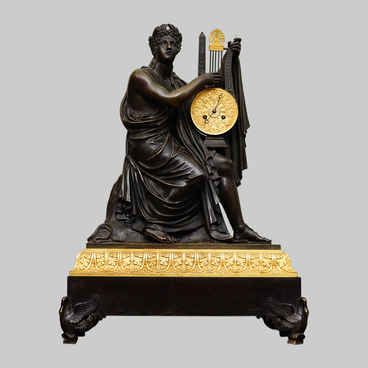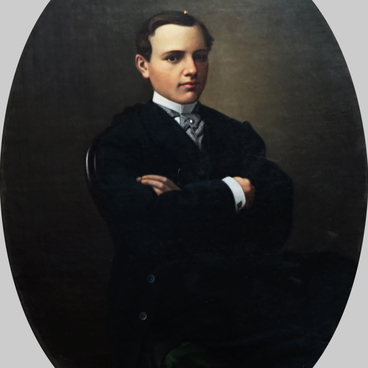Small oak cabinet, black. Veneered with black walnut (dyed and stained). The door features pilasters on the sides and a drawer at the top.
The themed composition in the center of the door depicts a group of people, probably negotiating a purchase. Two young men in sailor uniforms are standing on the seashore against the background of wooden houses. They are facing an old fisherman with a boat behind him. The composition is placed in an oval and is surrounded by Chinese-style geometric patterns.
Since the early 19th century, the words ‘G. Jacob’s style’ have been used to describe mahogany furniture with glued on ribbed brass strips. The style was named after its founder, Georges-Alphonse Jacob, who first started making such furniture in his workshops.
Georges Jacob was the first furniture maker to set the stage for the emergence of the Empire style. Many cabinet makers used his designs in their furniture and forged his stamp. The most famous forger of Georges Jacob’s stamp was Henri Jacob, with whom he shared the same last name. The furniture produced by Henri Jacob’s workshops was in no way inferior in quality to the works of his famous predecessor, and he received commissions from the court and various dignitaries.
This small cabinet presumably belonged to the Talyzin family from the Denezhnikovo estate situated in the Bronnitsy District.
Based on the known documents, the Talyzin family tree dates back to the 15th century. The names of its members are found in accounts of many significant events in the history of the Russian state.
The estate ensemble of Denezhnikovo was built by a member of the Admiralty Board since 1748, admiral Ivan Lukyanovich Talyzin (1700–1779). Ivan Lukyanovich was a relative of Nikita Ivanovich Panin, a diplomat in charge of the Russian foreign policy. Another relative of Ivan Talyzin was the Chancellor of the Russian Empire Alexey Petrovich Bestuzhev-Ryumin.
Eventually, Denezhnikovo passed on to Ivan Lukyanovich’s male heir, Alexander Fyodorovich Talyzin (1731–1787).
Alexander Talyzin played a prominent role in the plot to overthrow Peter III and crown Catherine the Great. The Empress entered Petersburg disguised in Talyzin’s uniform. This uniform was kept as an heirloom by the Apraksin family first in the village of Olgovo in the Moscow Province, and then in Denezhnikovo.
Suvorov visited the Denezhnikovo estate more than once. In 1795, he became the god-son of Stepan Aleksandrovich Talyzin. Subsequently, the commander’s godson, Alexander, married Suvorov’s granddaughter, Olga Nikolaevna Zubova (1803–1882).
Since then, portraits of the Zubovs and the Suvorovs have been on the walls of the house in Denezhnikovo. The portrait of Alexander Suvorov occupied a special and honorable place. In addition, the estate contained a large collection of the Field-Marshal’s belongings. In the park of the estate, there is an oak, which, according to legend, was planted by Suvorov himself.
After the death of Alexander Stepanovich Talyzin, Denezhnikovo was inherited by his children. In 1918, the estate was nationalized.
The themed composition in the center of the door depicts a group of people, probably negotiating a purchase. Two young men in sailor uniforms are standing on the seashore against the background of wooden houses. They are facing an old fisherman with a boat behind him. The composition is placed in an oval and is surrounded by Chinese-style geometric patterns.
Since the early 19th century, the words ‘G. Jacob’s style’ have been used to describe mahogany furniture with glued on ribbed brass strips. The style was named after its founder, Georges-Alphonse Jacob, who first started making such furniture in his workshops.
Georges Jacob was the first furniture maker to set the stage for the emergence of the Empire style. Many cabinet makers used his designs in their furniture and forged his stamp. The most famous forger of Georges Jacob’s stamp was Henri Jacob, with whom he shared the same last name. The furniture produced by Henri Jacob’s workshops was in no way inferior in quality to the works of his famous predecessor, and he received commissions from the court and various dignitaries.
This small cabinet presumably belonged to the Talyzin family from the Denezhnikovo estate situated in the Bronnitsy District.
Based on the known documents, the Talyzin family tree dates back to the 15th century. The names of its members are found in accounts of many significant events in the history of the Russian state.
The estate ensemble of Denezhnikovo was built by a member of the Admiralty Board since 1748, admiral Ivan Lukyanovich Talyzin (1700–1779). Ivan Lukyanovich was a relative of Nikita Ivanovich Panin, a diplomat in charge of the Russian foreign policy. Another relative of Ivan Talyzin was the Chancellor of the Russian Empire Alexey Petrovich Bestuzhev-Ryumin.
Eventually, Denezhnikovo passed on to Ivan Lukyanovich’s male heir, Alexander Fyodorovich Talyzin (1731–1787).
Alexander Talyzin played a prominent role in the plot to overthrow Peter III and crown Catherine the Great. The Empress entered Petersburg disguised in Talyzin’s uniform. This uniform was kept as an heirloom by the Apraksin family first in the village of Olgovo in the Moscow Province, and then in Denezhnikovo.
Suvorov visited the Denezhnikovo estate more than once. In 1795, he became the god-son of Stepan Aleksandrovich Talyzin. Subsequently, the commander’s godson, Alexander, married Suvorov’s granddaughter, Olga Nikolaevna Zubova (1803–1882).
Since then, portraits of the Zubovs and the Suvorovs have been on the walls of the house in Denezhnikovo. The portrait of Alexander Suvorov occupied a special and honorable place. In addition, the estate contained a large collection of the Field-Marshal’s belongings. In the park of the estate, there is an oak, which, according to legend, was planted by Suvorov himself.
After the death of Alexander Stepanovich Talyzin, Denezhnikovo was inherited by his children. In 1918, the estate was nationalized.

